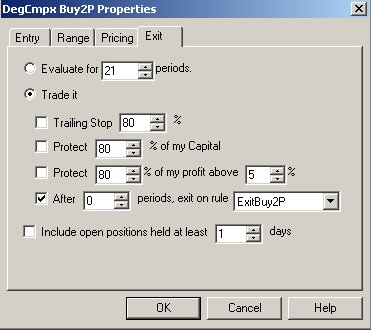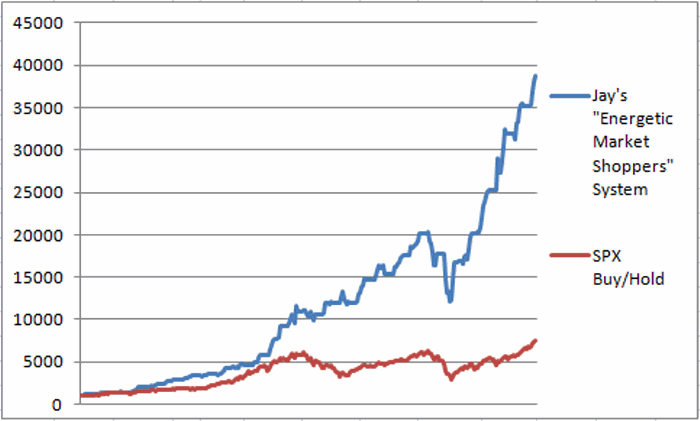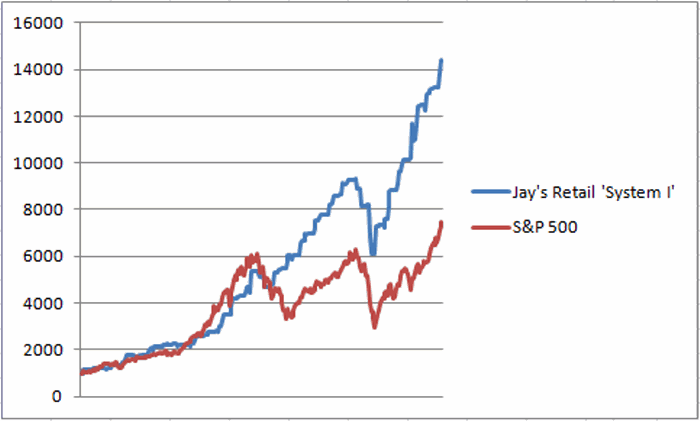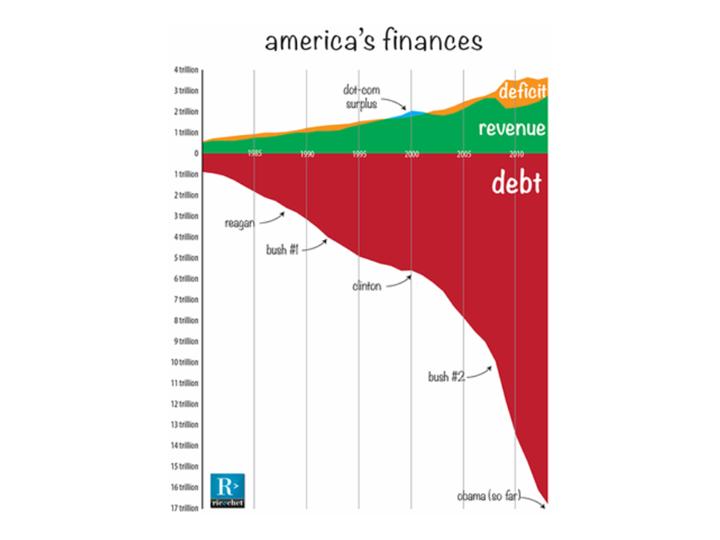Category Archives: Uncategorized
The Degree Of Complexity
| System | Entry rule | Exit rule | Entry price formula | Exit price formula |
| 2 Param-Long | Buy2P | ExitBuy2P | Buy2Ppr | ExitBuy2Ppr |
| 2 Param-Short | Sell2P | ExitSell2P | Sell2Ppr | ExitSell2Ppr |
| 4 Param-Long | Buy4P | ExitBuy4P | Buy4Ppr | ExitBuy4Ppr |
| 4 Param-Short | Sell4P | ExitSell4P | ell4Ppr | ExitSell4Ppr |
| 6 Param-Long | Buy6P | ExitBuy6P | Buy6Ppr | ExitBuy6Ppr |
| 6 Param-Short | Sell6P | ExitSell6P | Sell6Ppr | ExitSell6Ppr |
| 8 Param-Long | Buy8P | ExitBuy8P | Buy8Ppr | ExitBuy8Ppr |
| 8 Param-Short | Sell8P | ExitSell8P | Sell8Ppr | ExitSell8Ppr |
| 9 Param-Long | Buy9P | ExitBuy9P | Buy9Ppr | ExitBuy9Ppr |
| 9 Param-Short | Sell9P | ExitSell9P | Sell9Ppr | ExitSell9Ppr |


!THE DEGREE OF COMPLEXITY
!Author: Oscar G. Cagigas, TASC Feb 2014
!Coded by Richard Denning 12/7/13
!www.TradersEdgeSystems.com
! CODING ABBREVIATIONS:
C is [close].
H is [high].
L is [low].
O is [open].
PEP is {position entry price}.
PD is {position days}.
! PARAMETERS:
donLen1 is 40.
donLen2 is 15.
atrLen is 20.
atrMult is 1.0.
atrStop is 4.0.
maLen1 is 10.
maLen2 is 100.
rsiLen is 14.
rsiUpper is 70.
rsiLower is 30.
atrMult2 is 0.6.
minMov is 0.01.
!------------------------------------------------------------------
! AVERAGE TRUE RANGE (AS DEFINED BY WELLS WILDER)
WWE is 2*(atrLen-1).
TR is Max(H - L,max(abs(valresult(C,1) - L),abs(valresult(C,1)- H))).
ATR is expAvg(TR,WWE).
ATR1 is valresult(ATR,1).
!------------------------------------------------------------------
!! RSI WILDER
!To convert Wilder Averaging to Exponential Averaging use this formula:
!ExponentialPeriods = 2 * WilderPeriod - 1.
U is C-valresult(C,1).
D is valresult(C,1)-C.
eLen is 2 * rsiLen - 1.
AvgU is ExpAvg(iff(U>0,U,0),eLen).
AvgD is ExpAvg(iff(D>=0,D,0),eLen).
rsi is 100-(100/(1+(AvgU/AvgD))).
!----------------------------------------------------------------
!BASIC SYSTEM 2P (2 parameters):
HHdL1 is highresult(H,donLen1,1).
HHdL2 is highresult(H,donLen2,1).
LLdL1 is lowresult(L,donLen1,1).
LLdL2 is lowresult(L,donLen2,1).
Buy2P if H > HHdL1.
ExitBuy2P if L < LLdL2.
Sell2P if L < LLdL1.
ExitSell2P if H > HHdL2.
Buy2Ppr is max(O,HHdL1 + minMov).
ExitBuy2Ppr is iff(ExitBuy2P,min(O,LLdL2 - minMov),C).
Sell2Ppr is min(O,LLdL1 - minMov).
ExitSell2Ppr is max(O,HHdL2 + minMov).
!-----------------------------------------------------------------
!FOUR PARAMETER SYSTEM 4P:
Buy4P if H > HHdL1 and valrule(TR < atrMult*ATR,1).
EB4P1 if L < LLdL2.
EB4Pval is PEP - atrStop*valresult(ATR,PD).
EB4P2 if L < valresult(EB4Pval,1).
ExitBuy4P if EB4P1 or EB4P2.
Sell4P if L < LLdL1 and valrule(TR < atrMult*ATR,1).
ES4Pval is PEP + atrStop*valresult(ATR,PD) .
ES4P1 if H > HHdL2.
ES4P2 if H > valresult(ES4Pval,1).
ExitSell4P if ES4P1 or ES4P2.
Buy4Ppr is max(O,HHdL1 + minMov).
ExitBuy4Ppr is iff(EB4P1,min(O,LLdL2 - minMov),
iff(EB4P2,min(O,valresult(EB4Pval - minMov,1)),-99)).
Sell4Ppr is min(O,LLdL1 - minMov).
ExitSell4Ppr is iff(ES4P1,max(O,HHdL2 + minMov),
iff(ES4P2,max(O,valresult(ES4Pval + minMov,1)),-99)).
!----------------------------------------------------------------
!SIX PARAMETER SYSTEM 6P:
SMA1 is simpleavg(C,maLen1).
SMA2 is simpleavg(C,maLen2).
Buy6P if H > HHdL1 and valrule(TR < atrMult*ATR,1)
and valrule(SMA1 > SMA2,1).
EB6P1 if L < LLdL2.
EB6Pval is PEP - atrStop*valresult(ATR,PD).
EB6P2 if L < valresult(EB6Pval,1).
ExitBuy6P if EB6P1 or EB6P2.
Sell6P if L < LLdL1 and valrule(TR < atrMult*ATR,1)
and valrule(SMA1 < SMA2,1).
ES6Pval is PEP + atrStop*valresult(ATR,PD) .
ES6P1 if H > HHdL2.
ES6P2 if H > valresult(ES6Pval,1).
ExitSell6P if ES6P1 or ES6P2.
Buy6Ppr is max(O,HHdL1 + minMov).
ExitBuy6Ppr is iff(EB6P1,min(O,LLdL2 - minMov),
iff(EB6P2,min(O,valresult(EB6Pval - minMov,1)),-99)).
Sell6Ppr is min(O,LLdL1 - minMov).
ExitSell6Ppr is iff(ES6P1,max(O,HHdL2 + minMov),
iff(ES6P2,max(O,valresult(ES6Pval + minMov,1)),-99)).
!---------------------------------------------------------------
!EIGHT PARAMETER SYSTEM 8P:
Buy8P if H > HHdL1 and valrule(TR < atrMult*ATR,1)
and valrule(SMA1 > SMA2,1) and valrule(RSI >= rsiUpper,1).
EB8P1 if L < LLdL2.
EB8Pval is PEP - atrStop*valresult(ATR,PD).
EB8P2 if L < valresult(EB8Pval,1).
ExitBuy8P if EB8P1 or EB8P2.
Sell8P if L < LLdL1 and valrule(TR < atrMult*ATR,1)
and valrule(SMA1 < SMA2,1) and valrule(RSI <= rsiLower,1).
ES8Pval is PEP + atrStop*valresult(ATR,PD) .
ES8P1 if H > HHdL2.
ES8P2 if H > valresult(ES8Pval,1).
ExitSell8P if ES8P1 or ES8P2.
Buy8Ppr is max(O,HHdL1 + minMov).
ExitBuy8Ppr is iff(EB8P1,min(O,LLdL2 - minMov),
iff(EB8P2,min(O,valresult(EB8Pval - minMov,1)),-99)).
Sell8Ppr is min(O,LLdL1 - minMov).
ExitSell8Ppr is iff(ES8P1,max(O,HHdL2 + minMov),
iff(ES8P2,max(O,valresult(ES8Pval + minMov,1)),-99)).
!----------------------------------------------------------------
!NINE PARAMETER SYSTEM 9P:
Buy9P if H > HHdL1 and valrule(TR < atrMult*ATR,1)
and valrule(SMA1 > SMA2,1) and valrule(RSI >= rsiUpper,1)
and valrule(TR > atrmult2*ATR,1) .
EB9P1 if L < LLdL2.
EB9Pval is PEP - atrStop*valresult(ATR,PD).
EB9P2 if L < valresult(EB9Pval,1).
ExitBuy9P if EB9P1 or EB9P2.
Sell9P if L < LLdL1 and valrule(TR < atrMult*ATR,1)
and valrule(SMA1 < SMA2,1) and valrule(RSI <= rsiLower,1)
and valrule(TR > atrmult2*ATR,1) .
ES9Pval is PEP + atrStop*valresult(ATR,PD) .
ES9P1 if H > HHdL2.
ES9P2 if H > valresult(ES9Pval,1).
ExitSell9P if ES9P1 or ES9P2.
Buy9Ppr is max(O,HHdL1 + minMov).
ExitBuy9Ppr is iff(EB9P1,min(O,LLdL2 - minMov),
iff(EB9P2,min(O,valresult(EB9Pval - minMov,1)),-99)).
Sell9Ppr is min(O,LLdL1 - minMov).
ExitSell9Ppr is iff(ES9P1,max(O,HHdL2 + minMov),
iff(ES9P2,max(O,valresult(ES9Pval + minMov,1)),-99)).
!----------------------------------------------------------------
Jay’s ‘Energetic Market Shoppers’ System
In my previous article I wrote about a simple “system” – if you can even call it that – that involves buying retailing stocks four months out of the year and holding cash the rest of the year. As ridiculously simple as that sounds the fact of the matter is that if you earned just 1% of annualized interest while out of retailing stocks, the system outperformed a buy-and-hold approach by a fairly wide margin.
While the results of that simple system aren’t bad, as always, one can’t help but to look for ways to improve things. So this article will detail what I refer to as – and by the way, this is what I sound like when I refer to myself in the third person – “Jay’s Energetic Market Shoppers” System, or JEMS (clever, no?) for short. The name is derived from the investment vehicles involved:
1. J stands for, well, OK, Jay….
2. E stands for “Energetic”: Energy stocks have showed a historical tendency to rally in the spring so we will hold Fidelity Select Energy (ticker FSENX) during the month of April (other possibilities include tickers XLE and ENPIX).
3. M stands for “Market”: The stock market tends to perform well during November, December and January. We are already planning to hold retail stocks during November, but for December and January we will hold an S&P 500 index fund. For the purposes of this test we will use the S&P 500 Index itself from 1988 into 1997. From there we will use the ETF ticker SPY. Someone who wanted to keep it all in the Fidelity family could use ticker VFINX. (Another possibility is ticker BLPIX).
4. S is or “Shoppers”: Just as with the original system, we will hold Fidelity Select Sector Retailing (ticker FSRPX) during February, March, October and November (other possibilities include tickers XLY and CYPIX).
During May, June, July, August and September we will hold cash.
So here is the “lineup”
January SPY
February FSRPX
March FSRPX
April FSENX
May Cash
June Cash
July Cash
August Cash
September Cash
October FSRPX
November FSRPX
December SPY
So how does it work out? Not too badly. Figure 1 displays the growth of $1,000 using the JEMS System versus buying and holding the S&P 500.
 Figure 1 – Growth of $1,000 using “Jay’s Energetic Market Shoppers” System versus buying and holding the S&P 500 since 1988.
Figure 1 – Growth of $1,000 using “Jay’s Energetic Market Shoppers” System versus buying and holding the S&P 500 since 1988.Figure 2 displays the year-by-year results.
|
JEMS
|
S&P 500
|
|
JEMS
|
S&P 500
|
|
|
Annual %
|
Annual %
|
Difference
|
$1,000
|
$1,000
|
|
|
1988
|
25.4
|
12.4
|
7.0
|
1,254
|
1,124
|
|
1989
|
12.4
|
27.3
|
(27.6)
|
1,410
|
1,430
|
|
1990
|
12.2
|
(6.6)
|
28.7
|
1,582
|
1,336
|
|
1991
|
36.6
|
26.3
|
(9.4)
|
2,161
|
1,688
|
|
1992
|
27.7
|
4.5
|
16.6
|
2,760
|
1,763
|
|
1993
|
10.5
|
7.1
|
(0.1)
|
3,050
|
1,888
|
|
1994
|
10.5
|
(1.5)
|
0.7
|
3,369
|
1,859
|
|
1995
|
8.1
|
34.1
|
(31.1)
|
3,642
|
2,493
|
|
1996
|
19.5
|
20.3
|
(2.1)
|
4,353
|
2,998
|
|
1997
|
14.2
|
31.0
|
(18.4)
|
4,970
|
3,927
|
|
1998
|
50.5
|
26.7
|
14.3
|
7,479
|
4,975
|
|
1999
|
42.4
|
19.5
|
(7.9)
|
10,652
|
5,946
|
|
2000
|
(2.4)
|
(10.1)
|
19.4
|
10,400
|
5,343
|
|
2001
|
15.6
|
(13.0)
|
16.8
|
12,027
|
4,646
|
|
2002
|
3.5
|
(23.4)
|
36.9
|
12,450
|
3,561
|
|
2003
|
10.5
|
26.4
|
(16.6)
|
13,755
|
4,500
|
|
2004
|
18.9
|
9.0
|
4.6
|
16,354
|
4,905
|
|
2005
|
(1.1)
|
3.0
|
6.2
|
16,182
|
5,052
|
|
2006
|
14.8
|
13.6
|
(3.7)
|
18,574
|
5,740
|
|
2007
|
2.4
|
3.5
|
(5.3)
|
19,027
|
5,943
|
|
2008
|
(30.4)
|
(38.5)
|
7.0
|
13,237
|
3,656
|
|
2009
|
33.2
|
23.5
|
1.0
|
17,635
|
4,513
|
|
2010
|
32.5
|
12.8
|
14.0
|
23,366
|
5,090
|
|
2011
|
17.2
|
(0.0)
|
14.0
|
27,381
|
5,090
|
|
2012
|
21.3
|
13.4
|
4.7
|
33,204
|
5,772
|
|
2013
|
16.7
|
29.6
|
(18.2)
|
38,752
|
7,481
|
|
|
|||||
|
Average
|
16.3
|
9.6
|
1.3
|
||
|
StdDev
|
16.1
|
17.9
|
|||
|
Ave/SD
|
1.011
|
0.540
|
For the record:
-The JEMS System sported an average annual gain of +16.3%
-Buy/Hold sported an average annual gain of +9.6%
-$1,000 invested using the system grew to $38,752
-$1,000 invested using Buy/Hold grew to $7,481
-The JEMS system showed a gain in 23 of 26 calendar years (88.5%)
-The JEMS system showed a loss in 3 of 26 calendar years (12.5%)
-Buy/Hold showed a gain in 19 of 26 calendar years (73.1%)
-Buy/Hold showed a loss in 7 of 26 calendar years (26.9%)
-JEMS outperformed Buy/Hold in 15 of 26 calendar years (57.7%)
-Buy/Hold outperformed JEMS in 11 of 26 calendar years (42.3%)
Summary
So is the JEMS System the “world beater” system that everyone should be using? Well, on the plus side the long-term results are impressive relative to buy and hold. On the downside, there is still the sharp drawdown of 2008 that one would have had to continue to trade through. Also, the reality is that for most investors, a system like this involves more of a “leap of faith” than they are comfortable with.
Of course, as a proud graduate of “The School of Whatever Works” and as a founding member (OK, so far the only member) of “Seasonalaholics Unanimous!”……
………that’s just the way I like it.
Jay Kaeppel
Attention Shoppers! Part I
Hi, my name is Jay and I am a Seasonalaholic.
Now typically when someone confesses to being an “aholic” of some sort or another it because they recognize they have a problem and wish to correct it. That’s not the case here. In fact the “support” group that I belong to is not “Seasonalaholics Anonymous” but rather “Seasonalaholics Unanimous!” (OK, in the interest of full disclosure, so far I am the only member and yes, the monthly meetings aren’t terribly lively, but I digress).
Still I can’t help but think there are others out there who might join someday – especially after they consider things like the seasonal tendencies for retailing stocks. To whit: what would have happened had an investor invested in Fidelity Select Sector Retailing fund (ticker FSRPX):
-During the months of February, March, October and November
-And then earned 1% of annualized interest while out of the market the other 8 months.
The answer is contained in Figure 1 which displays the growth of $1,000 invested as described above.
 Figure 1 – Growth of $1,000 invested in FSRPX during February, March, October, November (blue line) versus buying and holding the S&P 500 red line) since January 1988.
Figure 1 – Growth of $1,000 invested in FSRPX during February, March, October, November (blue line) versus buying and holding the S&P 500 red line) since January 1988.Now it is pretty impossible to not notice the, ahem, “slight drawdown” experienced during the October, November 2008 period. Still, despite the fact that I have tried very hard scrub that particular time period from my memory bank, I still have some vague recollection that virtually no sector of the stock market was left unscathed during that period. And the rebound has been pretty nice.
So is this really a viable strategy? Well, under the category of “Everything is Relative”, Figure 2 displays the year-by-year performance of this “system” versus buying and holding the SP 500.
| System | SP 500 | System | SP 500 | ||
| Annual % | Annual % | Difference |
$1,000
|
$1,000
|
|
|
1988
|
18.6
|
12.4
|
6.2
|
1,186
|
1,124
|
|
1989
|
(1.0)
|
27.3
|
(28.2)
|
1,174
|
1,430
|
|
1990
|
21.3
|
(6.6)
|
27.8
|
1,424
|
1,336
|
|
1991
|
16.2
|
26.3
|
(10.1)
|
1,654
|
1,688
|
|
1992
|
20.4
|
4.5
|
15.9
|
1,992
|
1,763
|
|
1993
|
6.2
|
7.1
|
(0.9)
|
2,115
|
1,888
|
|
1994
|
(1.5)
|
(1.5)
|
0.0
|
2,083
|
1,859
|
|
1995
|
2.3
|
34.1
|
(31.8)
|
2,131
|
2,493
|
|
1996
|
17.4
|
20.3
|
(2.9)
|
2,500
|
2,998
|
|
1997
|
11.9
|
31.0
|
(19.1)
|
2,798
|
3,927
|
|
1998
|
40.1
|
26.7
|
13.4
|
3,919
|
4,975
|
|
1999
|
10.8
|
19.5
|
(8.7)
|
4,344
|
5,946
|
|
2000
|
8.5
|
(10.1)
|
18.7
|
4,714
|
5,343
|
|
2001
|
3.1
|
(13.0)
|
16.1
|
4,859
|
4,646
|
|
2002
|
12.8
|
(23.4)
|
36.2
|
5,480
|
3,561
|
|
2003
|
9.1
|
26.4
|
(17.3)
|
5,977
|
4,500
|
|
2004
|
12.8
|
9.0
|
3.8
|
6,744
|
4,905
|
|
2005
|
8.5
|
3.0
|
5.5
|
7,316
|
5,052
|
|
2006
|
9.2
|
13.6
|
(4.4)
|
7,991
|
5,740
|
|
2007
|
(2.4)
|
3.5
|
(6.0)
|
7,797
|
5,943
|
|
2008
|
(32.0)
|
(38.5)
|
6.5
|
5,303
|
3,656
|
|
2009
|
23.7
|
23.5
|
0.2
|
6,559
|
4,513
|
|
2010
|
26.0
|
12.8
|
13.2
|
8,263
|
5,090
|
|
2011
|
13.2
|
(0.0)
|
13.2
|
9,355
|
5,090
|
|
2012
|
17.3
|
13.4
|
3.9
|
10,976
|
5,772
|
|
2013
|
10.7
|
29.6
|
(18.9)
|
12,155
|
7,481
|
| Average |
10.9
|
9.6
|
1.3
|
+1,115% | 648% |
| StdDev |
12.8
|
17.9
|
|||
| Ave/SD |
0.849
|
0.540
|
Summary
The difference in the average annual return is not large (+10.9% for the system versus +9.6% for the S&P 500). But this difference adds up over time. Since January 1988 the system has gained +1,115% versus + 648% for the S&P 500 (while only being in the market 33% of the time. The true “numbers geeks” will notice that the standard deviation of annual returns for the system is only 2/3rds as large as that for the S&P 500 – i.e., much less volatility).
So I ask again, is this really a viable strategy? Perhaps. But the truth is that it can get a whole lot better – as I will detail the next time I write.
Jay Kaeppel
AIQ’s One Minute Stock presents ‘Going to the Candy Store’
To date, Hank Swiencinski aka The Professor, has delivered two sold out premium webinars to
traders, his powerful ‘Rifle Trades’ and his widely acclaimed ‘Trading
the Turns’.
The demand for these courses exceeded our quota both times,
so much so that we had to offer the recording and the seminar book as a
product after the events.
The Professor’s next premium event will be on
March 13, 2014 and it’s sure to sell out.
So what’s with the title? The Professor, will be presenting another webinar on March 14th that will focus on the techniques he uses to trade the
markets on event driven days like the Fed Announcement.
He calls these
techniques ‘Going to the Candy Store’. Like all of the techniques in the Professor’s Methodology, they are extremely easy to understand and apply. With
the right setup and technical analysis, these special days in the
market can be money in the bank. It’s not rocket science, it’s
commonsense and simple technique.




